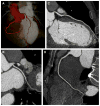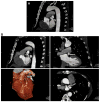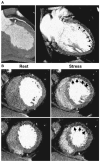The "post-64" era of coronary CT angiography: understanding new technology from physical principles
- PMID: 19195535
- PMCID: PMC2893874
- DOI: 10.1016/j.rcl.2008.11.001
The "post-64" era of coronary CT angiography: understanding new technology from physical principles
Abstract
Multidetector CT now provides noninvasive coronary imaging, and patients with a low or intermediate probability of coronary artery disease can be imaged with radiation levels comparable to catheterization. Cardiac imaging drives rapid progress in CT hardware. To best apply evolving technology, imagers and referring clinicians need a solid understanding of spatial resolution, temporal resolution, volume coverage, and radiation dose. This article defines and discusses interactions between these parameters for state-of-the-art CT.
Figures





References
-
- Budof MJ, Dowe D, Jollis J, et al. Diagnostic Performance of 64-Multidetector Row Coronary Computed Tomographic Angiography for Evaluation of Coronary Artery Stenosis in Individuals Without Known Coronary Artery Disease: Results From the Prospective Multicenter ACCURACY (Assessment by Coronary Computed Tomographic Angiography of Individuals Undergoing Invasive Coronary Angiography) Trial. J Am Coll Cardiol. 2008;52:1724–32. - PubMed
-
- Miller JM, Rochitte CE, Dewey M, et al. Diagnostic Performance of Coronary Angiography by 64-Row CT. N Engl J Med. 2008;359:2324–36. - PubMed
-
- Achenbach S. Cardiac CT: state of the art for the detection of coronary arterial stenosis. J Cardiovascular Computed Tomography. 2007;1:3–20. - PubMed
-
- Hoffmann U, Pena AJ, Cury RC, et al. Cardiac CT in emergency department patients with acute chest pain. Radiographics. 2006;26:963–78. discussion: 979–80. - PubMed
-
- Flohr TG, McCollough CH, Bruder H, et al. First performance evaluation of a dual-source CT (DSCT) system. Eur Radiol. 2006;16:256–68. - PubMed

